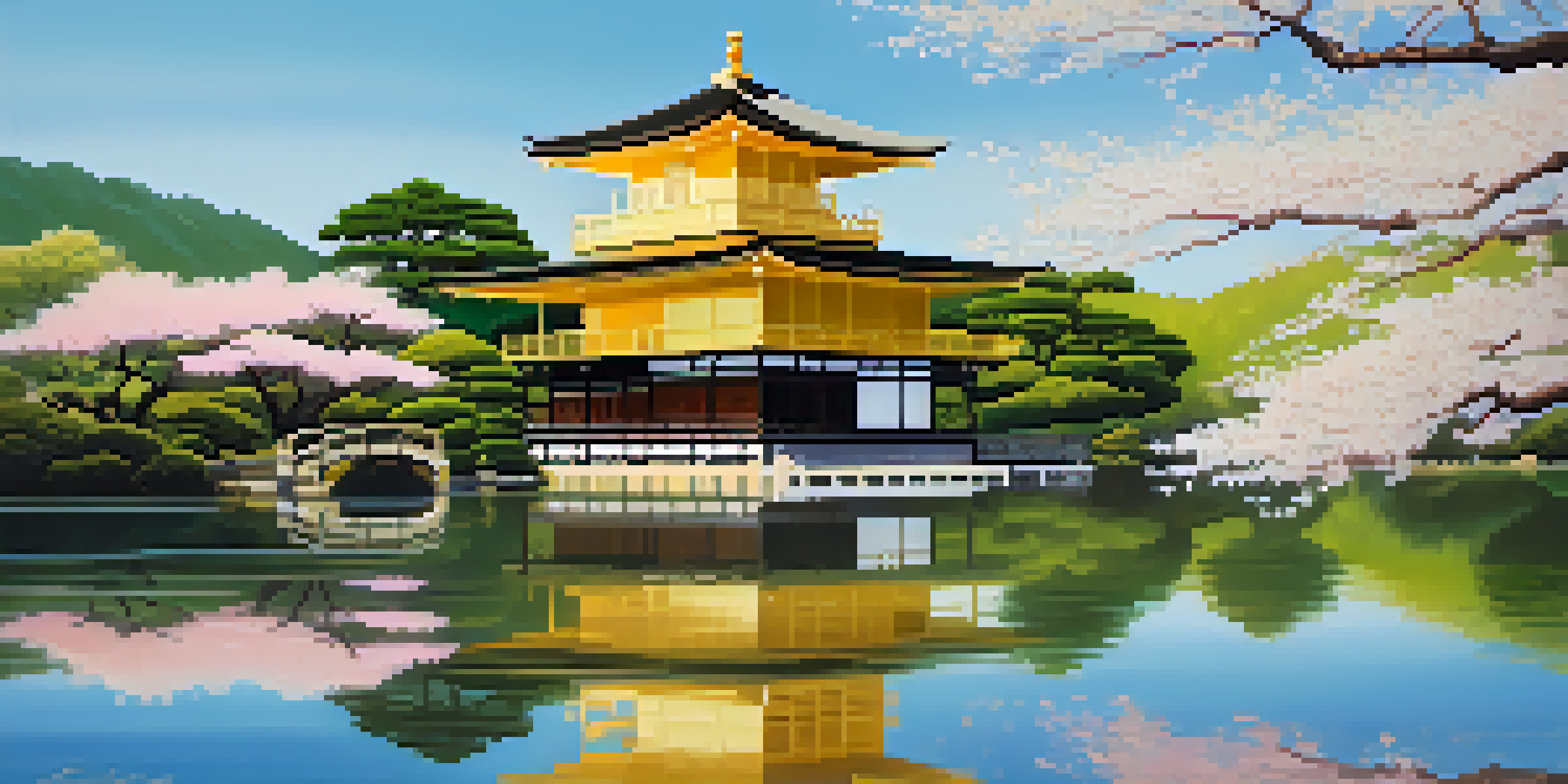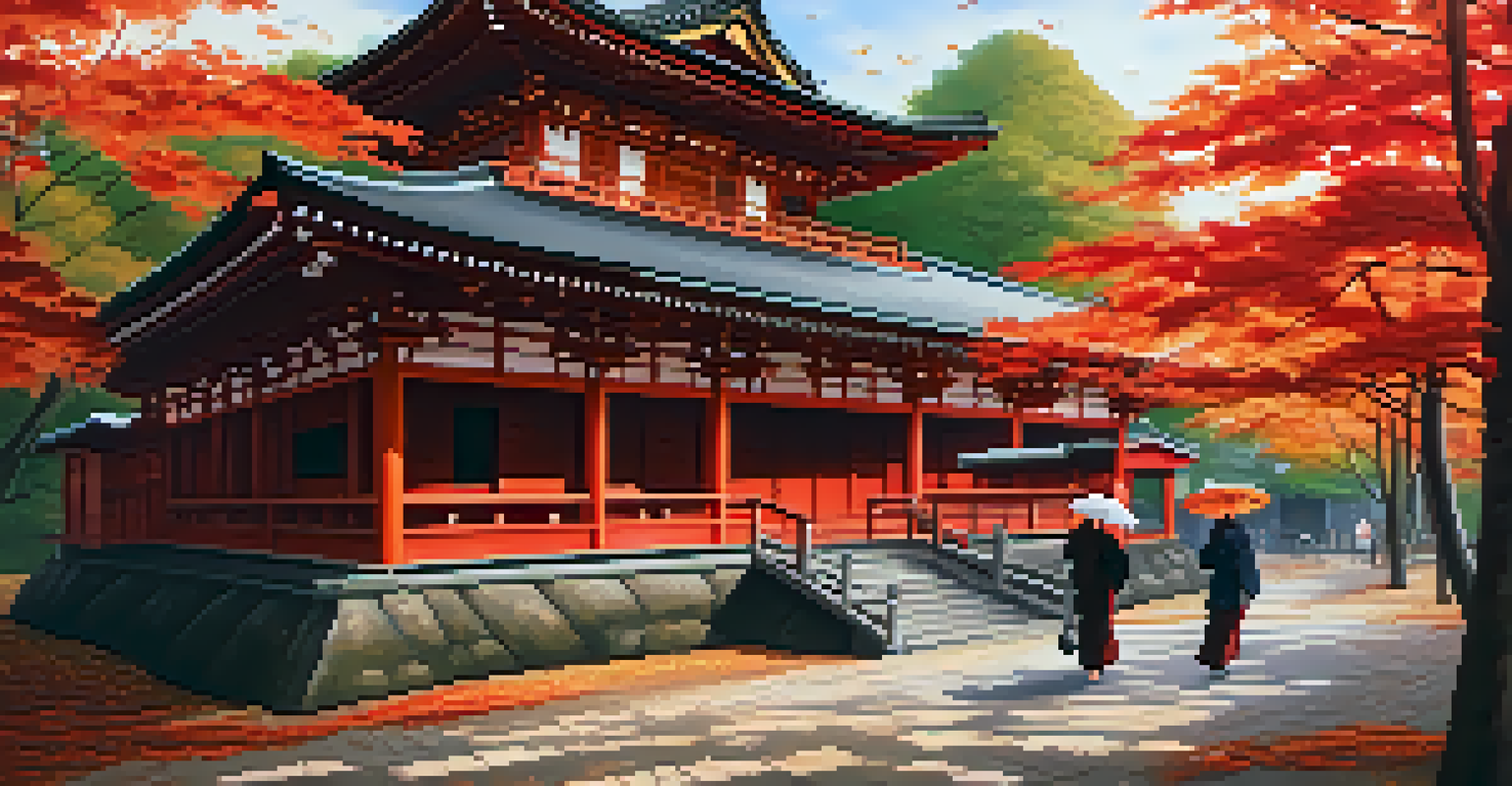Exploring the Rich Culture of Kyoto's Historic Temples

A Glimpse into Kyoto's Temple Legacy
Kyoto is often regarded as the cultural heart of Japan, and its temples are a testament to this rich heritage. With over 1,600 temples scattered across the city, each one tells a unique story that reflects the historical and spiritual evolution of the region. From Zen gardens to ornate pagodas, these structures are more than just places of worship; they are a vital part of Kyoto's identity.
The temple is a way of uniting the mind and the body, a place where one can find peace and harmony.
Many of these temples were established during the Heian period, which began in 794, marking a time of significant cultural development in Japan. This era saw the flourishing of arts, literature, and philosophy, and temples became important centers for these activities. As you explore Kyoto, it's fascinating to see how these ancient structures have withstood the test of time, continuing to inspire both locals and visitors alike.
In addition to their historical significance, these temples offer a serene escape from the bustling city. Walking through their grounds, adorned with cherry blossoms and tranquil ponds, provides a glimpse into the peaceful lifestyle of traditional Japan. This blend of history and tranquility makes Kyoto's temples a must-visit for anyone seeking to understand the city's profound cultural legacy.
The Architectural Wonders of Kyoto Temples
One of the most striking features of Kyoto's temples is their diverse architectural styles. From the simplicity of Zen architecture at Daitoku-ji to the intricate designs of Kinkaku-ji, each temple showcases a unique approach to aesthetics and function. The use of natural materials like wood and stone allows the structures to harmonize beautifully with their surroundings, creating a sense of peace and balance.

The iconic golden pavilion of Kinkaku-ji, for instance, is a stunning representation of Muromachi period architecture. Its reflective pond and lush gardens enhance the beauty of this UNESCO World Heritage Site, drawing visitors from around the globe. Similarly, the wooden structures of Kiyomizu-dera, perched on a hillside, offer breathtaking views of the city, demonstrating how architecture can complement nature.
Kyoto's Temples: Cultural Heart
Kyoto's temples showcase the city's rich cultural heritage, with over 1,600 unique structures that reveal the historical and spiritual evolution of the region.
These architectural marvels are not just visually appealing; they also carry deep spiritual meanings. Many temples incorporate symbols and designs that reflect Buddhist teachings, illustrating concepts of enlightenment and harmony. By appreciating the artistry of these temples, visitors can gain a deeper understanding of the philosophies that shaped Kyoto's cultural landscape.
Spiritual Practices and Traditions
Visiting Kyoto's temples provides an opportunity to witness various spiritual practices that have been passed down through generations. Many temples host ceremonies and rituals that invite visitors to engage with the spiritual aspects of Buddhism. For example, participating in a meditation session at a Zen temple allows one to experience the calming effects of mindfulness firsthand.
In the landscape of the mind, the temple is a place of serenity, a reminder of the beauty of impermanence.
Another common practice is the purification ritual known as temizu, where visitors wash their hands and mouths at a water basin before entering the temple grounds. This act symbolizes the cleansing of the mind and body, preparing oneself for a spiritual experience. Observing these rituals not only enhances your visit but also deepens your appreciation for the cultural significance of these practices.
Additionally, many temples offer prayers and blessings that visitors can partake in, such as writing wishes on wooden plaques called ema. This interactive element fosters a connection between the temple, its history, and the individuals who visit. By understanding and participating in these traditions, one can truly appreciate the living culture of Kyoto's temples.
Seasonal Festivals and Events
Kyoto's temples play a central role in various seasonal festivals and events throughout the year. The cherry blossom season in spring attracts thousands of visitors who come to admire the blossoms alongside the temples, creating a picturesque scene. Events like Hanami, or flower viewing, encourage people to gather and appreciate the fleeting beauty of nature, enhancing the cultural experience.
In autumn, the vibrant colors of maple leaves create a stunning backdrop for many temples, making it another peak time for visitors. Festivals such as Jidai Matsuri celebrate Kyoto's rich history through parades featuring traditional costumes from different eras. These events not only showcase the beauty of the temples but also highlight the strong connection between the community and its cultural heritage.
Zen Influence on Temple Design
The principles of Zen Buddhism profoundly shape both the architecture and spiritual practices found in Kyoto's temples, promoting mindfulness and harmony with nature.
Moreover, winter brings its own charm as some temples illuminate their gardens, creating a magical atmosphere. Experiencing these seasonal events allows visitors to see how temples serve as cultural hubs, bringing people together to celebrate the beauty of nature and tradition. Engaging with these festivities deepens your understanding of Kyoto's vibrant cultural landscape.
The Role of Zen Buddhism in Kyoto Temples
Zen Buddhism has profoundly influenced the culture and architecture of Kyoto's temples. This branch of Buddhism emphasizes meditation and mindfulness, which are reflected in the serene designs of many temples. Spaces like the rock gardens of Ryoan-ji invite contemplation and encourage visitors to connect with nature and their inner selves.
The practice of Zen is often encapsulated in the concept of 'Mono no Aware,' which translates to an awareness of the impermanence of things. This philosophy is beautifully illustrated in the changing seasons observed at the temples, where visitors witness the cycles of life in nature. Engaging with Zen practices, such as zazen (sitting meditation), offers a deeper understanding of this spiritual path.
Moreover, the influence of Zen extends beyond the temples into various aspects of Japanese culture, including tea ceremonies and traditional arts. By exploring the temples of Kyoto, one can appreciate how Zen principles have shaped not only religious practices but also everyday life in Japan. This interconnectedness enriches the experience of visiting these historic sites.
Culinary Delights Near the Temples
No exploration of Kyoto's temples is complete without indulging in the local cuisine that often accompanies these visits. Many temples are situated near traditional tea houses and restaurants that serve kaiseki, a multi-course meal showcasing seasonal ingredients. This culinary art form reflects the same attention to detail found in temple architecture, making it a delightful experience for the senses.
Additionally, the practice of enjoying matcha (green tea) in temple tea rooms adds to the cultural experience. Many temples offer tea ceremonies where visitors can learn about the significance of tea in Japanese culture while savoring the rich flavors. This moment of tranquility enhances the overall visit, allowing one to immerse in the serene atmosphere.
Culinary Delights Enhance Visits
Exploring Kyoto's temples is complemented by indulging in local cuisine, such as kaiseki and matcha, which reflect the city's culinary heritage.
Street food vendors near popular temples also offer a taste of local flavors, from yudofu (tofu hot pot) to sweet treats like yatsuhashi (cinnamon rice cakes). Sampling these dishes provides a deeper appreciation for Kyoto's culinary heritage, making it a perfect complement to the rich cultural experiences found within the temples.
Preserving the Heritage of Kyoto's Temples
As a city steeped in history, preserving the heritage of Kyoto's temples is of utmost importance. Many organizations and local governments work tirelessly to maintain these structures, ensuring that future generations can experience their beauty and significance. Restoration projects, often funded by donations, help to keep the temples in pristine condition while respecting their original architecture.
In addition to physical preservation, educational programs aim to raise awareness about the cultural and historical importance of these temples. Workshops and guided tours provide visitors with insights into the rituals, art, and architecture of Kyoto's temples, fostering a deeper connection between people and this cultural heritage. This emphasis on education helps ensure that the stories and traditions of these temples are not forgotten.

Moreover, the community plays a vital role in preserving temple heritage. Local residents often participate in temple activities and festivals, reinforcing their ties to these historic sites. By engaging with the temples in meaningful ways, both locals and visitors contribute to the ongoing legacy of Kyoto's rich cultural tapestry.